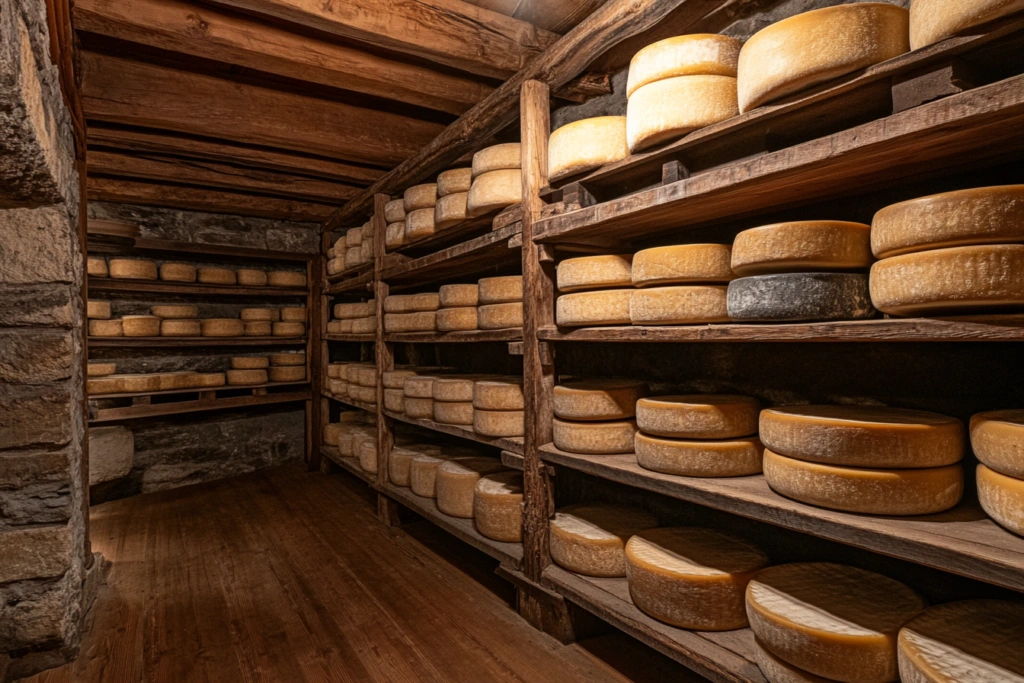1. Introduction to Gruyere Cheese
Gruyere cheese is a Swiss treasure renowned for its rich, nutty flavor and smooth texture. Often featured in gourmet dishes, this versatile cheese has become a kitchen staple worldwide. From fondue to grilled sandwiches, Gruyere’s melting quality and distinct flavor profile make it a go-to ingredient for both chefs and home cooks.
Its history dates back centuries, and its protected status (AOP) ensures that authentic Gruyere is still made using traditional methods. Whether you’re looking to learn about its origins, nutritional benefits, or best pairings, this guide covers everything you need to know about Gruyere cheese.
By the end of this article, you’ll understand:
- What makes Gruyere unique.
- How to use it in recipes.
- Proper storage methods to preserve flavor and freshness.
2. History and Origin of Gruyere Cheese
2.1 Origins in Switzerland

Gruyere cheese originates from the Gruyères region in Switzerland, where it has been crafted since 1115 AD. Its name comes directly from this picturesque town, which is surrounded by lush Alpine pastures.
Historically, farmers in Gruyères developed this cheese as a way to preserve milk and create a long-lasting product. Over the years, it gained global recognition, becoming a symbol of Swiss culinary excellence.
2.2 Traditional Production Methods
Authentic Gruyere cheese is made from unpasteurized cow’s milk, giving it a creamy texture and deep flavor. The process involves:
- Heating milk and adding rennet to form curds.
- Pressing the curds into molds to create a firm wheel.
- Aging the cheese for 5 to 12 months, depending on the desired flavor intensity.
During aging, wheels of Gruyere are stored in caves with controlled humidity, which contributes to its earthy aroma and distinct taste.
2.3 Global Recognition
Gruyere’s AOP status (Appellation d’Origine Protégée) protects its authenticity. This certification ensures that only cheeses produced in the Gruyères region following strict guidelines can be labeled as Gruyere.
Today, Gruyere is widely used in European cuisine and has become a favorite ingredient for dishes worldwide. Its balance of creaminess and nuttiness makes it ideal for melting, baking, and grating.
3. Taste and Texture of Gruyere Cheese
Gruyere cheese is celebrated for its distinct flavor profile and versatile texture, making it a favorite in culinary dishes and cheese boards. Whether freshly sliced or melted, it adds depth and richness to any recipe.
3.1 Flavor Profile
The taste of Gruyere cheese evolves as it ages, offering a range of flavors that appeal to different palates:
- Young Gruyere (5–6 months):
- Mild, creamy, and slightly sweet.
- Perfect for melting in dishes like mac and cheese or fondue.
- Aged Gruyere (12+ months):
- Complex, nutty, and earthy.
- Ideal for grating over dishes like French onion soup or pasta.
Its flavor is often described as buttery, with hints of almonds, hazelnuts, and caramelized notes, especially in aged varieties.
3.2 Texture
Gruyere cheese also transforms in texture based on its aging process:
- Fresh and Young Gruyere:
- Smooth, creamy, and pliable.
- Ideal for melting into sauces, dips, or casseroles.
- Mature Gruyere:
- Firm and slightly grainy.
- Suitable for shredding, slicing, or grating over salads and baked dishes.
Its semi-hard consistency allows it to maintain structure even when melted, making it perfect for baked gratins and soufflés.
3.3 Comparison with Other Cheeses
Gruyere cheese is often compared to other European cheeses, but it has unique qualities:
| Cheese | Taste | Texture | Best Use |
|---|---|---|---|
| Emmental | Mild and slightly nutty | Firm and elastic | Fondue and sandwiches |
| Comté | Stronger, earthy, and fruity | Dense with slight crystallization | French recipes and cheese boards |
| Parmesan | Sharp and salty | Hard and granular | Grated toppings for pasta and soups |
| Fontina | Buttery and mild | Semi-soft and creamy | Melting in sauces and dips |
Quick Tip: If you need a Gruyere substitute, Comté or Emmental are the closest matches in flavor and melting quality.
4. Nutritional Benefits of Gruyere Cheese
Gruyere cheese is not only a flavorful addition to meals but also a source of important nutrients. It provides proteins, vitamins, and minerals that contribute to a balanced diet. While it is often enjoyed in moderation due to its fat content, it delivers multiple health benefits when consumed as part of a healthy lifestyle.
4.1 Macronutrients
Gruyere cheese is rich in macronutrients that support energy and muscle growth.
Calories and Protein:
A one-ounce serving contains approximately 117 calories and nine grams of protein. This makes it a satisfying snack and a great way to add protein to recipes.
Healthy Fats:
Gruyere contains seven grams of fat per serving, most of which are saturated fats that provide energy and support cell growth. The fat content also helps in absorbing fat-soluble vitamins like A and D.
Carbohydrates:
With less than one gram of carbohydrates per serving, Gruyere is ideal for low-carb and ketogenic diets.
4.2 Vitamins and Minerals
Gruyere cheese is packed with essential vitamins and minerals that contribute to bone strength, immunity, and energy levels. It provides calcium, phosphorus, and vitamin A, supporting bone health and immune function. (Learn more about the health benefits of cheese here.)
Calcium and Phosphorus:
These minerals are essential for strong bones and teeth, helping to prevent osteoporosis and promote healthy aging. One ounce of Gruyere delivers about 287 milligrams of calcium, making it one of the best dairy sources of this mineral.
Vitamin A:
Vitamin A supports vision, skin health, and immune function. Gruyere provides a significant portion of daily vitamin A requirements.
Zinc and Selenium:
Both minerals are vital for immune system support, wound healing, and maintaining healthy skin.
4.3 Dietary Considerations
Gruyere cheese fits into a variety of diets but may not be suitable for everyone.
Low-Carb and Keto Diets:
Due to its minimal carbohydrate content, Gruyere is an excellent option for ketogenic and low-carb eating plans.
Lactose Sensitivity:
Gruyere is naturally low in lactose, especially when aged, making it easier to digest for those with lactose intolerance.
Caloric Content:
Because it is calorie-dense, portion control is recommended for those monitoring their caloric intake.
5. Culinary Uses of Gruyere Cheese
Gruyere cheese is prized in kitchens worldwide for its versatility. Its creamy texture when melted and rich flavor make it an ideal ingredient for both simple dishes and gourmet recipes. Whether baked, melted, or sliced, Gruyere can transform meals into indulgent experiences.
5.1 Melting Properties
Gruyere cheese is known for its excellent melting qualities, making it a key ingredient in warm and creamy dishes. Its smooth texture allows it to blend seamlessly into sauces, soups, and casseroles without becoming stringy or oily.
Because of this, Gruyere is often used in recipes that require a rich and gooey consistency, including fondues, gratins, and baked pastas. It is also commonly layered in casseroles, providing both flavor and structure.
5.2 Popular Recipes

French Onion Soup:
Gruyere is famously used to top French onion soup. It melts into a bubbly, golden crust that contrasts perfectly with the rich broth underneath. Its nutty flavor complements the caramelized onions, creating a hearty and savory dish.
Gruyere Mac and Cheese:
A luxurious alternative to traditional mac and cheese, Gruyere provides a creamy texture and nutty flavor. It melts smoothly into the cheese sauce, making it ideal for baked pasta dishes.
Quiche Lorraine:
Gruyere adds depth to quiches, enhancing the custard filling with its distinct flavor. It pairs well with ingredients like ham, spinach, and mushrooms, making it a go-to cheese for savory pies.
Croque Monsieur and Croque Madame:
These classic French sandwiches feature Gruyere melted over ham and bread, with an optional fried egg on top. The result is a decadent, comforting dish perfect for brunch or lunch.
5.3 Gourmet Uses
Gruyere cheese’s rich flavor makes it a star ingredient in high-end dishes and party platters.
Cheese Boards:
Gruyere pairs beautifully with fruits such as grapes, pears, and figs, as well as nuts like walnuts and almonds. Add crackers or slices of baguette to create a visually appealing cheese platter.
Grilled Cheese Sandwiches:
Its smooth melting quality makes it perfect for gourmet grilled cheese sandwiches, adding a creamy interior with crispy, toasted bread.
Soufflés and Tarts:
Gruyere enhances the flavor and texture of baked dishes like soufflés and savory tarts, offering a combination of lightness and richness in every bite.
6. Best Food Pairings with Gruyere Cheese
Gruyere cheese pairs well with a variety of foods, making it a versatile addition to meals and appetizers. Its nutty and slightly sweet flavor complements both savory and sweet ingredients, creating endless pairing possibilities.
6.1 Perfect Pairings with Fruits and Nuts
Fruits:
Gruyere cheese balances beautifully with fruits that provide a hint of sweetness. Some popular options include:
- Fresh grapes, apples, and pears for a crisp and juicy contrast.
- Dried fruits such as apricots, figs, and dates for a chewy and sweet balance.
Nuts:
Nuts enhance the earthy notes of Gruyere. Ideal choices are:
- Walnuts and almonds for a crunchy texture.
- Hazelnuts for a buttery, rich flavor.
Tip: Pair Gruyere with sliced apples and walnuts for an elegant snack platter.
6.2 Bread and Crackers to Serve with Gruyere
Bread and crackers act as a neutral base, allowing the rich flavors of Gruyere cheese to shine.
Bread Options:
- French baguettes with a crisp crust and chewy interior.
- Whole-grain or seeded bread for added texture and fiber.
Crackers:
- Plain water crackers to let the cheese stand out.
- Multigrain or herb-infused crackers for extra flavor.
For entertaining, arrange Gruyere slices with a variety of crackers and breadsticks to create an inviting cheese board.
6.3 Vegetables and Meats to Complement Gruyere
Vegetables:
Gruyere pairs well with both raw and cooked vegetables.
- Roasted asparagus, broccoli, and Brussels sprouts complement its nutty flavor.
- Fresh cherry tomatoes and cucumbers add crispness and freshness.
Meats:
Gruyere works wonderfully with deli meats and roasted options.
- Sliced turkey and chicken are lighter options that balance Gruyere’s richness.
- Thinly sliced roast beef enhances its savory notes.
Tip: Use Gruyere in wraps or sandwiches with roasted chicken and lettuce for a satisfying lunch.
6.4 Snack and Appetizer Ideas
Gruyere cheese can be the centerpiece of both simple and sophisticated snacks. For more snack ideas, consider pairing Gruyere-based dishes with crowd-pleasers like this taco dip recipe at your next gathering.
Quick Snacks:
- Melt Gruyere on whole-grain crackers and top with cherry tomatoes or cucumber slices.
- Spread Gruyere over toasted bread and drizzle with honey for a sweet and savory treat.
Appetizers:
- Create stuffed mushrooms by mixing Gruyere with spinach and breadcrumbs.
- Make mini cheese tarts using puff pastry, caramelized onions, and melted Gruyere.
Gruyere’s ability to complement sweet, savory, and crunchy elements makes it ideal for entertaining or quick bites.
7. Substitutes for Gruyere Cheese
Gruyere cheese is highly versatile, but there may be times when it’s unavailable, or dietary preferences require an alternative. Fortunately, several substitutes match Gruyere’s flavor profile and melting properties, ensuring your dishes maintain their quality.
7.1 Similar Cheese Alternatives
Emmental Cheese
- Offers a mild, slightly nutty flavor similar to Gruyere.
- Melts easily, making it ideal for fondues, sandwiches, and casseroles.
- Often used interchangeably with Gruyere in recipes.
Comté Cheese
- Provides a richer and more complex flavor with nutty undertones.
- Matches Gruyere in texture and melting ability, especially for baked dishes.
- Commonly used in French recipes and gratins.
Jarlsberg Cheese
- Slightly milder and sweeter than Gruyere, but still melts well.
- Suitable for quiches, sandwiches, and pasta dishes.
- Budget-friendly and widely available.
Fontina Cheese
- Creamy and buttery flavor with excellent melting qualities.
- Works well in sauces, pasta bakes, and soups.
Quick Tip: Use Emmental or Comté for recipes that highlight Gruyere’s melting ability, such as casseroles and soups.
7.2 Vegan and Dairy-Free Alternatives
Cashew-Based Cheese
- Creamy texture and mild flavor make it a suitable substitute for spreads and sauces.
- Often fortified with nutritional yeast for a nutty flavor similar to Gruyere.
Almond Cheese
- Offers a firmer texture, ideal for slicing and grating.
- Melts moderately well, making it useful in sandwiches or tarts.
Nutritional Yeast Blends
- Adds a rich, cheesy flavor without dairy.
- Perfect for sprinkling over pasta or blending into dips.
Quick Tip: For vegan recipes, blend cashew cheese with plant-based milk to create a creamy sauce reminiscent of melted Gruyere.
7.3 Recipe-Specific Substitutes
Fondue:
- Use a mix of Emmental and Jarlsberg for a creamy and smooth consistency.
French Onion Soup:
- Comté is the best substitute due to its ability to create a golden, bubbly crust.
Mac and Cheese:
- Fontina or Gouda offers a rich and creamy base while maintaining good melting properties.
8. Frequently Asked Questions (FAQs)
8.1 What Does Gruyere Cheese Taste Like?
Gruyere cheese has a nutty, creamy, and slightly sweet flavor when it is young. As it ages, the flavor becomes more complex, earthy, and slightly salty, offering a rich depth that makes it versatile for both cooking and snacking.
8.2 Can You Eat Gruyere Cheese Raw?
Yes, Gruyere cheese can be eaten raw. It’s delicious when served on cheese platters, paired with fruits, nuts, and crackers. Its smooth texture and mild flavor make it perfect for sandwiches, salads, or even quick snacks straight from the block.
8.3 What Is Gruyere Cheese Best Used For?
Gruyere cheese is widely used in:
- Melting dishes like fondue and mac and cheese due to its smooth texture.
- Baked recipes such as quiche Lorraine and casseroles.
- Toppings for soups like French onion soup.
- Sandwiches and grilled cheese for a gooey, flavorful bite.
- Cheese boards paired with fruits, nuts, and crackers.
8.4 Is Gruyere Cheese Good for Melting?
Yes, Gruyere is excellent for melting. Its smooth texture prevents it from becoming stringy or oily, making it ideal for fondue, sauces, and gratin dishes. It also browns beautifully, adding a crispy layer to baked recipes.
8.5 What Are the Best Substitutes for Gruyere?
If Gruyere is unavailable, several cheeses work as substitutes:
- Emmental: Similar flavor and melting quality.
- Comté: Rich, nutty taste, ideal for baked dishes.
- Fontina: Buttery and creamy, perfect for sauces.
- Jarlsberg: Milder, budget-friendly option.
For vegan options, cashew-based cheeses and nutritional yeast blends offer similar creamy textures.
9. Conclusion
Gruyere cheese is a timeless classic that has earned its reputation as one of the most versatile cheeses available. With its rich, nutty flavor and smooth texture, it’s the perfect addition to a variety of dishes, including baked casseroles, soups, sandwiches, and cheese platters.
Beyond its culinary appeal, Gruyere is also nutrient-rich, providing protein, calcium, and essential vitamins. Whether you’re exploring classic recipes, looking for substitutes, or experimenting with cheese pairings, Gruyere offers something for everyone.
With proper storage tips, melting techniques, and serving suggestions, you can enjoy Gruyere’s delicious flavor and creamy texture in both everyday meals and special occasions.
Try incorporating Gruyere into your next recipe and experience the timeless charm of this Swiss delight!
